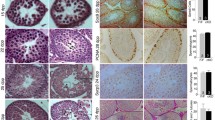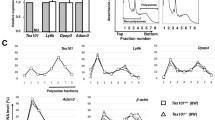Abstract
By targeted deletion of either the FUT1- or FUT2-gene for α1,2-fucosyltransferase, expression of FGM1 and FGA1, in murine testis was revealed to be sustained through unique interchangeability of the genes, indicating their significant roles for spermatogenesis. Accordingly, we examined the amounts of FGM1 and FGA1 in the testes of mice at 1–42 days after birth in comparison to those of several glycolipids including seminolipid. Although Forssman antigen and GM1 were present in relatively constant amounts during the period examined, GM3, which was the major one at 1 day, quickly decreased during development and had completely disappeared at 4 weeks. The following glycolipids were expressed in stage-specific manners, FGM1 for primary spermatocytes at 1 week, a seminolipid for secondary spermatocytes at 2 weeks, and GM3 lactone and FGA1 for spermatids and spermatozoa at 3 weeks. In fact, immunohistochemical staining with anti-FGM1 and anti-FGA1 antibodies demonstrated that FGM1 and FGA1 were distributed in the spermatocytes, and the spermatids and spermatozoa, respectively, and FGA1, together with seminolipid, were the immunogenic markers of spermatozoa. Thus, the fucosylation of glycolipids is a spermatogenesis-associated event, which should occur even with use of either the FUT1- or FUT2-gene.



Similar content being viewed by others
References
Iwamori M. A new turning point in glycosphingolipid research. Hum Cell. 2005;18(3):117–33.
Ishizuka I, Suzuki M, Yamakawa T. Isolation and characterization of a novel sulfoglycolipid, ‘seminolipid’, from boar testis and spermatozoa. J Biochem. 1973;73(1):77–87.
Zhang Y, Hayashi Y, Cheng X, Watanabe T, Wang X, Taniguchi N, Honke K. Testis-specific sulfoglycolipid, seminolipid, is essential for germ cell function in spermatogenesis. Glycobiology. 2005;15(6):649–54.
Honke K, Hirahara Y, Dupree J, Suzuki K, Popko B, Fukushima K, Fukushima J, Nagasawa T, Yoshida N, Wada Y, Taniguchi N. Paranodal junction formation and spermatogenesis require sulfoglycolipids. Proc Natl Acad Sci USA. 2002;99(7):4227–32.
Ishizuka I. Chemistry and functional distribution of sulfoglycolipids. Prog Lipid Res. 1997;36(4):245–319.
Takamiya K, Yamamoto A, Furukawa K, Zhao J, Fukumoto S, Yamashiro S, Okada M, Haraguchi M, Shin M, Kishikawa M, Shiku H, Aizawa S, Furukawa K. Complex gangliosides are essential in spermatogenesis of mice: possible roles in the transport of testosterone. Proc Natl Acad Sci USA. 1998;95(21):12147–52.
Lin B, Saito M, Sakakibara Y, Hayashi Y, Yanagisawa M, Iwamori M. Characterization of three members of murine alpha1,2-fucosyltransferases: change in the expression of the Se gene in the intestine of mice after administration of microbes. Arch Biochem Biophys. 2001;388(2):207–15.
Iwamori M, Domino SE. Tissue-specific loss of fucosylated glycolipids in mice with targeted deletion of alpha(1,2)fucosyltransferase genes. Biochem J. 2004;380(Pt 1):75–81.
Watkins WM. Biochemistry and genetics of the ABO, Lewis, and P blood group systems. Adv Hum Genet. 1980;10(1–136):379–85.
IUPAC-IUB Commission on Biochemical Nomenclature. The nomenclature of lipids. Eur J Biochem. 1977;179:11–21.
Svennerholm L. Chromatographic separation of human brain gangliosides. J Neurochem. 1963;10:613–23.
Tanaka K, Suzuki A, Aoki D, Iwamori M. Characterization of a novel glycolipid with a difucosylated H-antigen in human blood group O erythrocytes with monoclonal antibody HMMC-1 and its detection in human uterine cervical carcinoma tissues. Glycoconj J. 2019;36(3):219–26.
Nores GA, Dohi T, Taniguchi M, Hakomori S. Density-dependent recognition of cell surface GM3 by a certain anti-melanoma antibody, and GM3 lactone as a possible immunogen: requirements for tumor-associated antigen and immunogen. J Immunol. 1987;139(9):3171–6.
Russell L, Ettlin R, Sinha Hikimi A, Clegg E. Histological and histopathological evaluation of the testis. Clearwater: Cache, River Press; 1990.
Iwamori M, Tanaka K, Adachi S, Aoki D, Nomura T. Enhanced fucosylation of GA1 in the digestive tracts of X-ray-irradiated mice. Glycoconj J. 2017;34(2):163–9.
Domino SE, Hiraiwa N, Lowe JB. Molecular cloning, chromosomal assignment and tissue-specific expression of a murine alpha(1,2)fucosyltransferase expressed in thymic and epididymal epithelial cells. Biochem J. 1997;327(Pt 1):105–15.
Domino SE, Zhang L, Gillespie PJ, Saunders TL, Lowe JB. Deficiency of reproductive tract alpha(1,2)fucosylated glycans and normal fertility in mice with targeted deletions of the FUT1 or FUT2 alpha(1,2)fucosyltransferase locus. Mol Cell Biol. 2001;21(24):8336–45.
Raychoudhury SS, Millette CF. Multiple fucosyltransferases and their carbohydrate ligands are involved in spermatogenic cell-Sertoli cell adhesion in vitro in rats. Biol Reprod. 1997;56(5):1268–73.
Ueno K, Ishizuka I, Yamakawa T. Glycolipid composition of human testis at different ages and the stereochemical configuration of seminolipid. Biochim Biophys Acta. 1977;487(1):61–73.
Acknowledgements
This work was supported in part by a grant-in-aid for scientific research from the Japanese Ministry of Education, Culture, Sports, Science and Technology (Grant no. 17K11295, Kyoko Tanaka).
Author information
Authors and Affiliations
Corresponding author
Ethics declarations
Conflict of interest
The authors declare that they have no conflicts of interest.
Ethical approval
All applicable international, national, and/or institutional guidelines for the care and use of animals were followed.
Additional information
Publisher's Note
Springer Nature remains neutral with regard to jurisdictional claims in published maps and institutional affiliations.
Rights and permissions
About this article
Cite this article
Iwamori, M., Adachi, S., Lin, B. et al. Spermatogenesis-associated changes of fucosylated glycolipids in murine testis. Human Cell 33, 23–28 (2020). https://doi.org/10.1007/s13577-019-00304-x
Received:
Accepted:
Published:
Issue Date:
DOI: https://doi.org/10.1007/s13577-019-00304-x




